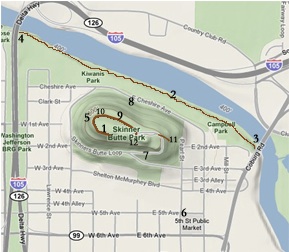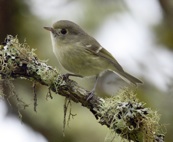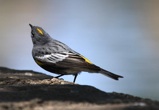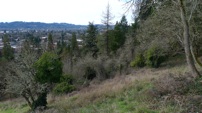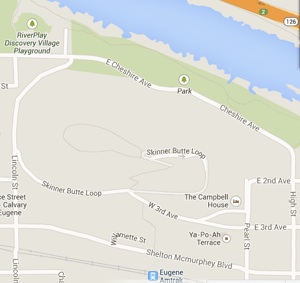Skinner Butte




Skinner Butte is named after Eugene Skinner, city co-founder and first mayor.
At 110–acres, Skinner Butte Park includes the Butte and adjacent riverfront park and trails extending from the Ferry Street Bridge (3) west to the Jefferson-Washington Street Bridge (4) crossing near Valley River Center. The Butte is a basaltic intrusion; one can view cliffs of columnar basalt being used by rock climbers on its west side (5). People love to come to the Butte to get a bird’s eye view of downtown and the South Hills, including Spencer Butte. To the east you can view the Willamette River, Alton Baker Park, and two of the Three Sisters peaks in the high Cascades.
Sightings:
There are three birds you have to see atop Skinner Butte: warblers, warblers, and more warblers. From mid-April to mid-May, the Butte is the most popular Eugene location for watching land bird migration. Sitting above the Willamette River, the Butte serves as a migrant trap. In the mornings, warblers are joined by migrating tanagers, grosbeaks, vireos, and flycatchers, and when conditions are right during the peak spring period, you will be joined by other birders Your neck will be stiff from gazing up into the maples and firs at branches lit up as colorfully as a flower garden with yellow, orange, green, and black and white birds.
The bird list for the Park totals 146 species; habitat diversity is a feature of this urban park. Walking up the Butte from 3rd Avenue and Pearl Streets one can find Chestnut-backed Chickadee and Hutton’s Vireo (7). Cooper’s Hawks sometimes nest among the Cedars. The north side (8) of the Butte is heavily forested by Douglas and Grand Firs, with a Big Leaf Maple understory. The top (9) of the loop trail is good year-round for forest species like Brown Creeper, Winter Wren, and Golden-crowned Kinglet. In winter, Varied Thrush feed along the trail. In spring, both Hermit and Swainson’s Thrushes can be seen; you can watch dozens of Western Tanagers, as well. Osprey have nested on a the Butte; Bald Eagles have raised young from an occasional north slope nest, as have Great Horned Owls and Cooper's Hawks. A maze of improved dirt trails criss-crosses the north side and can be followed to the base of the Butte.
As you work your way around the top loop, listen for the mixed flocks of birds. The northwest corner (10) is often a hot spot. On this corner and near the parking lot are two good locations for Lesser Goldfinch. There is a clearing on the east side (11) of the Butte that is worth checking for hummingbirds, flycatchers, warblers, and sparrows. Check the area south (12) of the parking lot for Anna’s Hummingbirds, atop small trees. Overhead, scan for Violet-green Swallows, Vaux’s Swifts, and the occasional Black Swift. The paved path along the Willamette River (2) below the Butte is good for riparian species and waterbirds. Lesser Scaup and Common Merganser are found on the River in winter. In late spring, Willow Flycatchers and Yellow Warblers can be found among the willows.
Skinner Butte Park offers easy connection to other birding sites along the Willamette River. You can continue downstream to Maurie Jacobs landing (4) to study gulls in winter or continue further downstream, crossing the Valley River footbridge, to bird Delta Ponds. Upstream from Skinner Butte, you can cross the DeFazio footbridge and bird Alton Baker Park. After birding you can venture to the shops and restaurants on Fifth Street (6).
